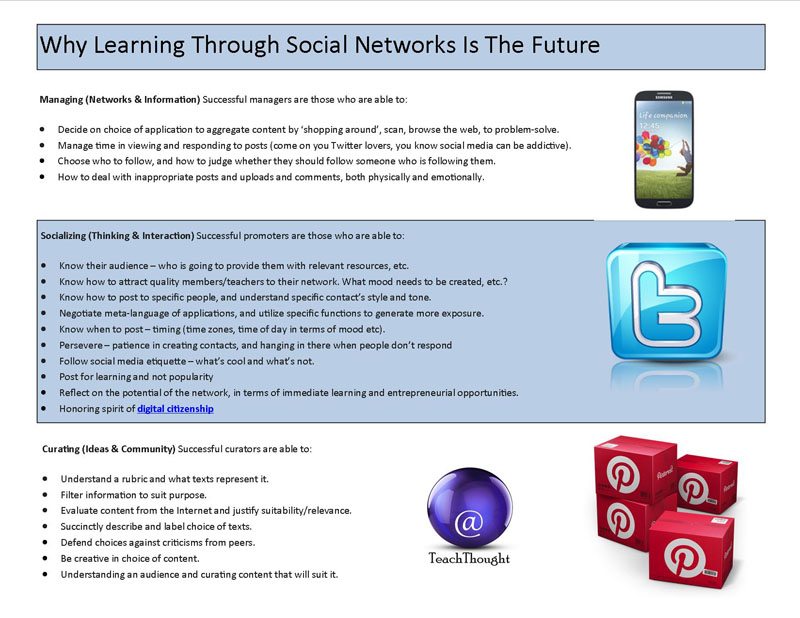by TeachThought Staff
Learning Through Social Networks Is The Future
Learning to create, manage and promote a professional learning network (PLN) will soon become, if it’s not already, one of the most necessary and sought after skills for a global citizen, and as such, must become a prominent feature of any school curriculum.
Few progressive educationalists would argue that a personal learning network (PLN) is not incredibly valuable and important. Passionate advocates including Murray, Whitby, and Sheninger lead with clarity in such discussions. The wealth of professional development that stems from such a network is quickly defining it as an essential tool for teachers, and will, I believe, replace organized costly professional development undertaken by organizations.
See also 7 Skills Students Will Always Need: Future-Proofing School
However presently, few discussions and promotions of PLN’s venture further than lauding specific benefits for teachers. But why just teachers, and not students? Could students benefit from a network of learners? Considering the importance of exams in determining futures, it seems that professional development for students not only has unbounded potential but must be taught as a matter of urgency.
Establishing a PLN seems simple enough on the surface, but to do it successfully and optimize its potential contains within in it a challenging and vigorous set of learning opportunities. Curating, managing, and promoting a PLN develops critical, creative, 21st century, and an increasingly important set of socio-emotional capabilities. Integration into modern curriculums would be seamless. Of course, the best way to teach is to show, not tell, so here is a list, but by no means a definitive list, of the skills that are learned.
3 Social Learning Verbs Critical To Learning Through Networks
1. Curating (Ideas & Community)
To curate or not to curate – that is actually not the question. The question is how good are you at it. In a world where information is amassing exponentially on the internet, becoming skillful at filtering and selecting appropriate information will become imperative, and much sooner than we think.
The trend is irrefutable (Rosenbaum), and can facilitate reaching political disruption as Twitter founder Evan Williams notes. Some education companies are emerging who understand the context, but exponents agree that successful curators are those who are able to:
- Understand a rubric and what texts represent it.
- Filter information to suit purpose.
- Evaluate content from the Internet and justify suitability/relevance.
- Succinctly describe and label choice of texts.
- Defend choices against criticisms from peers.
- Be creative in choice of content. Understanding an audience and curating content that will suit it, including considering context, use of humor, use of suitable language.
2. Managing (Networks & Information)
Successful managers are those who are able to:
- Decide on choice of application to aggregate content by ‘shopping around’, scan, browse the web, and listen to peers, etc. to ascertain the best solution.
- Manage time in viewing and responding to posts (come on you Twitter lovers, you know social media can be addictive).
- Choose who to follow, and how to judge whether they should follow someone who is following them.
- How to deal with inappropriate posts and uploads and comments, both physically and emotionally.
3. Socializing (Thinking & Interaction)
This develops a range of enterprise skills, beginning with knowledge of creating a theme or mood or personal brand. Successful promoters are those who are able to:
- Know their audience – who is going to provide them with relevant resources, and who is going to connect them to others who have quality resources
- Know how to attract quality members/teachers to their network. What mood needs to be created, and is it consistent over their posts and uploads?
- Know the importance of posting good quality content.
- Know how to post to specific people, and understand specific contact’s style and tone
- Negotiate meta-language of applications, and utilize specific functions to generate more exposure, including using tags effectively.
- Know when to post – timing (time zones, time of day in terms of mood, etc).
- Persevere – patience in creating contacts, and hanging in there when people don’t respond
- Follow social media etiquette – what’s cool and what’s not.
- Post for learning and not popularity
- Reflect on the potential of the network, in terms of immediate learning and entrepreneurial opportunities.
- Honoring spirit of digital citizenship
Learning Through Social Networks
The advantages of learning such skills are clear, but there is one ultimate perk. Learning through social networks can result in the creation of an independent learner, a learner who can adapt to changing contexts by engaging their network, a learner who can confidently navigate through the jungle of the connected digital landscape. But let’s not make students wait while teachers themselves come to terms with the power of the PLN. Students already have a very solid prior knowledge of the power and functionality of networks. They enthusiastically engage with them every day for social and entertainment purposes. The skilled teacher is the one who can take that prior knowledge and enthusiasm and teach students to leverage it to their learning advantage.
Networking is not just a trend, a fad that will die out soon enough. The success of Facebook, Twitter, and LinkedIn is not simply a result of cool fashionable technology. Dawson suggests networking is actually very intuitive, and his analogy of it as an organic breathing entity is useful. Indeed, all nature is organized in such a fashion, from DNA and cell functionality to chemistry to successful social interaction. Many things benefit from not being in isolation.
Defoe’s Robinson Crusoe was a warning, not just a story. Let’s not let students leave school in isolation, with only Friday on their minds. Let’s ensure they are well connected, independent, and empowered to learn anywhere, anytime.
